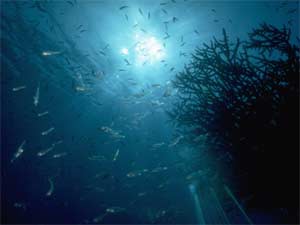How deep is the deepest part of the ocean? Does anything live down there?
 I didn't have to dig very deep to find the answer to this one. I simply typed "deepest part of the ocean" into Google and uncovered several web pages that answered your question.
I didn't have to dig very deep to find the answer to this one. I simply typed "deepest part of the ocean" into Google and uncovered several web pages that answered your question.My first stop was ScienceNet, a British web site that purports to be a one-stop science site. We couldn't dispute that claim after they provided us with the facts of the matter: The Marianas Trench in the Pacific Ocean is 11,033 meters (36,201 feet) below sea level. If Mount Everest were placed inside of this trench, it would disappear.
At Oceanclopedia, we learned that the deepest part of the trench is named Vitjazdepth. The trench was formed when the Pacific plate collided with the Philippine plate, which also resulted in the formation of the nearby island Guam.
To find out if anything actually lives down there, we swam over to Earth & Sky, a companion site to the popular science radio series. We discovered that plants can't live at such depths because they need sunlight for photosynthesis -- light doesn't penetrate such depths.
However, recent photographs from unmanned craft show shrimp-like crustaceans, sea cucumbers, and marine worms. In addition, bacteria flourish on the muddy floors of the trenches.
Receive post updates by Email



























 Add my feed to your Rss
Add my feed to your Rss
